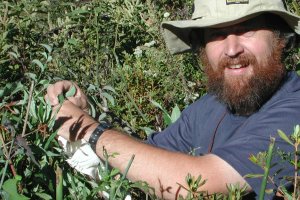
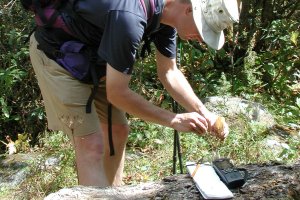
Collecting Seed Material


Fruits and seeds were collected in the field along with herbarium voucher specimens whenever possible. As for herbarium material notes on locality, habitat and plant habit were noted to be entered later into the Collecting Book. Some seeds and dry, indehiscent fruits were placed directly into paper packets in the field, but the majority of the collections were placed into 'bird bags'. These are small, cotton bags (ca. 15 x 25 cm) with a draw string at the top. They are intended to be used for keeping live birds in during ringing excercises, and we buy them from ornithological suppliers (e.g. British Trust for Ornithology). Bird bags are useful for dry dehiscent fruit as the fruits can be kept until they split and the seed released, but these bags are essential for fleshy fruit that needs to be dried before they go mouldy.
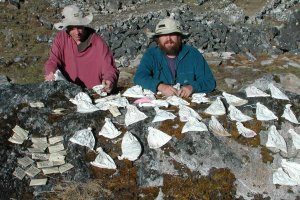
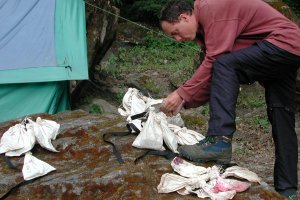
Fleshy fruits (e.g. Sorbus, Arisaema) are placed in the bag, the top knotted, and the whole bag crushed to split the fruit. This can be spectacularly messy for juicy fruits and the excess liquid needs to be squeezed out before it has any chance of drying. The seed bags can be air dried on lines or spread out over hot rocks in the sun, or suspended on strings over the heated drying frame.
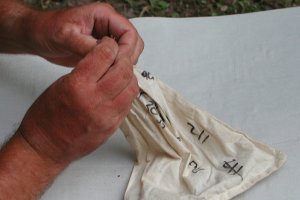
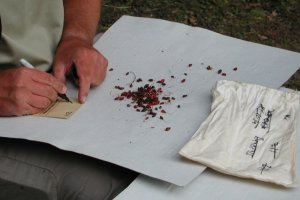
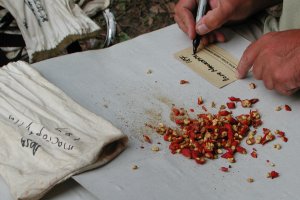
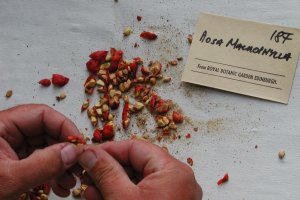
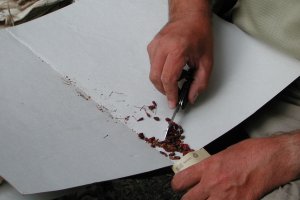
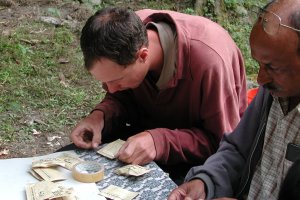
Once fleshy fruits are dry, or dry dehiscent fruits have shed their seed, the seed can be removed from the bag, cleaned, and packeted. The finished seed packets are sealed with sellotape to stop small seeds escaping, and the packets stored in a cool, dry place.
The Preparation,
Cleaning and Sowing of Seed
If carried out properly
and patiently the cleaning, and sowing of seed is a time consuming and
laborious task. However, taking into account the time, money and effort
that goes into expeditions and its benefit to the plant in the long term,
it is well worth the extra effort. The process can be categorised as
follows;
Fleshy fruit
eg. Sorbus, Berberis, Acteae
The ‘pulp’ or fleshy part
of the fruit in many genera contains an inhibitor which needs to be removed
to allow for germination to take place, it also allows for the individual
seeds to be handled easier. This can be carried out in a variety of methods,
at RBGE we find that separating the pulp from the seed in a bowl of water
works efficiently, as the pulp falls to the bottom of the bowl whilst the
viable seed floats to the top (this can also be taken as a guide to separating
the viable from the non-viable seed, the non-viable falling to the base).
In some genera (Berberis) where the fleshy ‘pulp’ is apparently
not a germination inhibitor it is still good practice to remove the ‘pulp’
as each fruit contains a number of seeds and if not separated this can
lead to erratic germination in the seed pan. Many plants, especially members
of the Rosaceae, require a period of seed stratification. Consequently
the seed pans are placed outdoors for the winter, once germination has
been achieved (generally during the first or second spring), the seedlings
are brought into the glasshouse and grown on in individual pots.
Dry seed eg.
Spiraea, Primula, Meconopsis
As a rule, dry seed is the
most time consuming to clean. The seed particularly in genera such as Primula
and Meconopsis is tiny, and can be difficult to separate from the
seed capsules if the capsules become broken during extraction of the seed.
A method used at RBGE is using a variety of fine sieves of different sizes.
The seeds are generally of about similar size or smaller than the
capsule debris and so can be separated relatively easy. Mechanical systems
which involve powered fans separating the seed from the debris are used
on large scale commercial enterprises.
Monocotyledons
eg. Arisaema, Ophiopogon
The seed of many monocotyledons
contain germination inhibitors. These can be eradicated by imbibing (soaking)
them in soapy water, for a given period of time, eg. 24 hours. This starts
an osmotic process whereby the germination inhibitor leaches out of the
seed and is replaced by the water. Soap added to the water enables the
water to pass more easily into the seed.